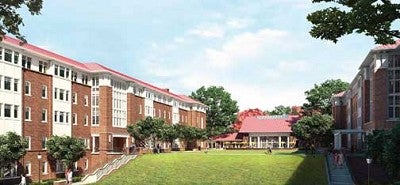Master Plan Gears Up
Published 5:19 pm Thursday, June 28, 2012
FARMVILLE – With enrollment planned to reach 5,600 by 2020-it will be close to 4,700 this fall-Longwood University continues preparing to house and educate its expanding student body while keeping its promise not to use eminent domain to seize property adjacent to the campus.
A major piece to the puzzle is the student residence hall construction underway at Longwood's north campus at Lancer Park, due to be ready for students in the fall of 2013.
The Farmville Industrial Development Authority (IDA) approved revenue bond financing for the North Campus Apartments, or North Campus Residential Village, on Wednesday morning.
The project includes two four-and-a-half story residence halls, with a commons building at one end.
“They're able to borrow the money, since it's an educational institution, they're eligible to borrow on a tax-free basis,” Town Manager Gerald Spates explained.
“Basically, all we're doing is saying, 'Yeah, it's eligible' and we sign off on the documents,” he said. “But it's no financial obligation whatsoever on the Town.”
The Town and its IDA are acting as the door, or portal, through which the Longwood University Real Estate Foundation is passing in order to use the bond financing.
Longwood has used bond financing through the Town before, as have Hampden-Sydney College and Centra Southside Community Hospital, the town manager noted.
“There's no obligation on our part,” Spates repeated. “As a matter of fact, we get a percentage for doing the deal. I think the last time we got $90,000.”
The housing construction on the north side of High Bridge Trail State Park off West Third Street is part of the ripple effect of Longwood's master planning for its future.
“These three buildings are effectively going to replace the Cunninghams,” real estate foundation executive director Ken Copeland explained.
There are 450 beds in the Cunningham dorm space and 454 beds will be created at the north campus site.
The construction also includes a commons building that will provide food service and exercise/recreation facilities.
“We're going to have over 700 students living on this site,” Copeland said of the north campus.
The architectural design of the North Campus Apartments is clearly classic Longwood.
“What we tried in every way we could was to bring Longwood's architecture to the north campus,” Copeland said, “because nothing on the Stanley Park site now looks like Longwood. This is going to.”
The design will creatively replicate some of the architectural “signatures” on the main campus.
In fact, the U-shape of the two main residence halls, combined with the commons at one end, will create an effect not unlike the University of Virginia's famed lawn in between the buildings-a grassy space where students can gather, read, relax, or play.
As this project demonstrates, the roll-out of Longwood's master plan is well underway.
The plan calls for a new student union building to be constructed on campus where the Cunningham dorms now stand. The existing student union will become an annex to the Greenwood Library.
“If we're going to grow enrollment-and the plan for the 2020 vision is to grow enrollment to 5,600 over the next eight years. We're going to be about 4,700, I think, this fall-then we've got to free up some space on campus for the core mission and that's education,” Copeland said.
Longwood's information systems, currently housed in the Coyner Building, will be transferred to French, which will no longer have its swimming pool.
“French will not be a residence hall but we still want to house freshmen and a good portion of the sophomores on campus,” Copeland continued. “If we're going to do that then we've got to decide do we want our core academic mission to be met in the boundaries of this triangle (the main campus) or do we want to put academic space outside the boundaries of the triangle?”
Copeland believes Longwood's answer is “ideal” because it keeps academic space on the main campus, along with student housing for freshmen and sophomores.
Upper class status brings the privilege of living off the main campus and the university, itself, can offer Midtown Square, Lancer Park or Longwood Village, he noted.
Regarding revenue bond financing through Farmville's IDA, Copeland said the bond total will not exceed $45 million for the North Campus Apartments project. “I don't think it will go that high but it gives us some flexibility.”
Economically, the time was exactly right for the bond financing.
“This was the time to do it. We had originally thought of waiting closer to the end of construction,” Copeland said. But the market set the stage for an accelerated schedule.
“It was time to move quickly…and the Board of Visitors wasn't going to meet again until September so we kinda rushed at the last minute to get a resolution in front of the board (this month), which they unanimously approved,” Copeland said.
“By doing that the proceeds from the sale of those bonds, as they're traded in the market place, nobody pays any income tax on the earnings from these bonds. That's why they're referred to as tax-exempt bonds,” Copeland explained.
Longwood University and the real estate foundation have been down this road before.
“Basically, it's the same drill we went through in 2007 when we financed Midtown (Square) and Stanley Park in 2006 through the IDA. Then we bought Longwood Village late that year and had an opportunity to refinance that and roll it into a single financing about a year and half later,” he said. “So it's essentially the same moving parts, the same type of structure to what we did…”
There will be a refinancing component, too.
“There's a lot of moving parts…We have an opportunity to refinance the financing that we did in 2007 at a better rate than what we had then and we were doing victory laps in '07,” Copeland said.
“It's what attorneys refer to as a bifurcated deal-it's got two parts, two pieces,” he explained. “One would be about $41 million to refinance what's already in the market and this 45 (million dollars) would be stand alone on the new project….It's north of $85 million total but they're already the issuer of 41 of that 85 (million dollars),” he pointed out.
The four, two, and single-bedroom apartments are due for occupancy for the fall 2013 semester, with substantial completion by June 30, 2013.
“That will give us the rest of the summer to furnish it, shakedown…to make sure,” Copeland concluded, “it's ready for occupancy when students roll in here that August.”






